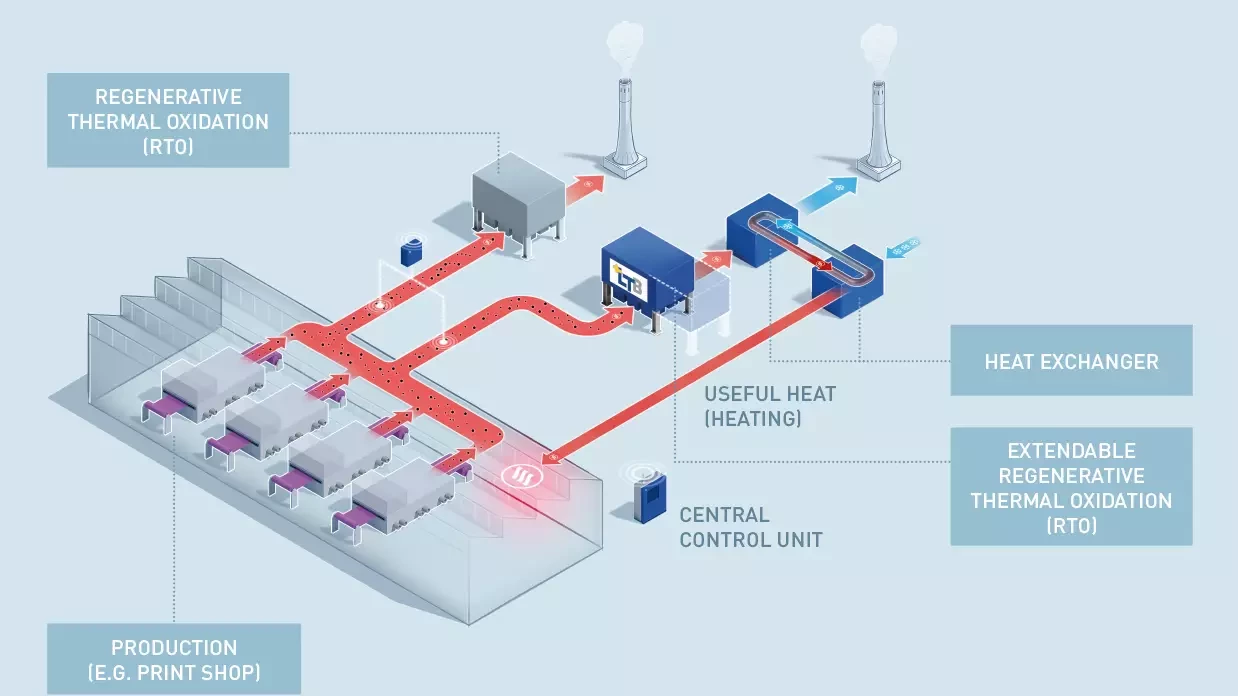Printing gossamer nonwovens is an art in itself and is an innovative alternative to foil printing. Innowo Print, owned by the Danish company Fibertex Personal Care, is the global market leader in this field. The loading in the print shop, based in Ilsenburg in the northern Harz region, are full and the existing exhaust air purification system had reached the limits of its capacity. “We needed to extend to ensure that the official emission values were met. We wanted a concept that would link the old and new systems so we could use it to control the total volume of exhaust air,” says Albert Steffen, Managing Director of Innowo Print, in explaining the requirements needed.
The solution consists of an exhaust air purification system from LTB based on regenerative thermal oxidation (RTO). The new system is rated for 15,000 Nm3/h of exhaust air. It requires much less energy during continuous operation than the old exhaust air system from a thirdparty manufacturer and also features heat recovery. The existing pipe network was modified to enable both systems to be serviced from one manifold. The exhaust air volumes are coordinated by a higherlevel control system so that both systems operate in their respective optimum operating conditions. This ensures that the old system is operated as costeffectively as possible, and the new, more efficient RTO is operated at maximum capacity. The capability of LTB to execute this energy optimized integration project like it is shown in picture 1 even though the existing installation was delivered by another supplier was a main decision criterion for Innowo Print to start the joint project work.
Making costeffective use of energy from exhaust air
The solvents used in the printing process release a large amount of energy during the combustion process, which used to be lost as hot exhaust air through the stack at Innowo Print. “Our goal is to minimize environmental pollution along the entire manufacturing process. Our customers also increasingly want to know how we are making our production more resourceefficient. Therefore the new exhaust air purification system combined with heat recovery is not just logical for us, but also costeffective,” says Steffen.
Innowo Print will spend much less on heating in the future, since the energy recovered from afterburning through a 600 kW hot water heat exchanger will be used for factory air conditioning. With a heating period of 4,000 hours annually, this will reduce the amount of heat required by an average of 250 kW which will no longer need to be purchased as primary energy. This will result in a savings of around EUR 40,000 per year, which means that the heat exchanger will pay itself off within 18 short months.
In order to be prepared for further growth, the new system including the heat exchanger was designed from the onset in such a way that the exhaust air capacity could be doubled to 30,000 Nm³/h with little technical effort. The LTB unit is designed so that the system can be easily extended within a few days if necessary. This is much faster and less expensive than building a brand new system.
Service for high operational reliability
The reliable availability of exhaust air purification systems is extremely important for the printing industry. “You need an afterburning system to get an operating license for a printing plant of this size. If this system were to fail, we would no longer be able to operate the print shop and would have to shut down the presses. We can’t have that,” spells out Steffen. Dürr offers a comprehensive service package and worldwide support with service centers close to the customer that are also used by the subsidiary LTB. This was an important factor in Innowo Print’s decision to award the contract. LTB has a service team available to the print shop located in Ilsenburg just two hours away in Goldkronach. As well as maintenance and repairs, the service package also includes performance improvements to the systems. This involves analyzing the data recorded by the systems and making appropriate adjustments to the parameters in order to further optimize operating costs.
During the building work, more stringent noise requirements were discovered and met, arising from a new noise study that was conducted. The noise emissions coming from the factory premises had to be reduced by 10 dB(A). Dürr accomplished this by performing all the necessary measures, including insulating the main sources of noise like the fan and the valve system on Innowo’s existing RTO from a thirdparty manufacturer. Table 1 compares the configuration of both air purification systems.
Demand for printed nonwovens is also growing in Asia. In order to meet this growing demand, Fibertex, Innowo Print’s parent company, built its own plant in Malaysia. Even though it is not a statutory requirement in the South East Asian country, the print shop was equipped with a RTO rated for 20,000 Nm3/h (picture 2) in order to ensure ecofriendly production in accordance with European standards. The project was designed in Germany by Dürr and supported by their subsidiary in Malaysia with local experience and proximity to the customer, which contributed to the smooth and timely commissioning.
“Our cooperation with LTB was completely professional and purposeful. Preliminary discussions focused on gathering information in order to identify our requirements. LTB then used this information to come up with competent proposals that enabled us to quickly find the right system for us. The project was also completed very promptly,” says Steffen in summarizing the company’s experiences of the two projects.



